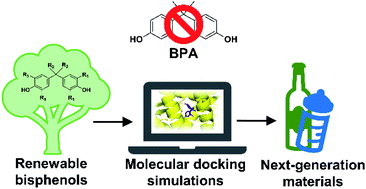Estrogenic activity of lignin-derivable alternatives to bisphenol A assessed via molecular docking simulations†
Abstract
Lignin-derivable bisphenols are potential alternatives to bisphenol A (BPA), a suspected endocrine disruptor; however, a greater understanding of structure–activity relationships (SARs) associated with such lignin-derivable building blocks is necessary to move replacement efforts forward. This study focuses on the prediction of bisphenol estrogenic activity (EA) to inform the design of potentially safer BPA alternatives. To achieve this goal, the binding affinities to estrogen receptor alpha (ERα) of lignin-derivable bisphenols were calculated via molecular docking simulations and correlated to median effective concentration (EC50) values using an empirical correlation curve created from known EC50 values and binding affinities of commercial (bis)phenols. Based on the correlation curve, lignin-derivable bisphenols with binding affinities weaker than ∼−6.0 kcal mol−1 were expected to exhibit no EA, and further analysis suggested that having two methoxy groups on an aromatic ring of the bio-derivable bisphenol was largely responsible for the reduction in binding to ERα. Such dimethoxy aromatics are readily sourced from the depolymerization of hardwood biomass. Additionally, bulkier substituents on the bridging carbon of lignin-bisphenols, like diethyl or dimethoxy, were shown to weaken binding to ERα. And, as the bio-derivable aromatics maintain major structural similarities to BPA, the resultant polymeric materials should possess comparable/equivalent thermal (e.g., glass transition temperatures, thermal decomposition temperatures) and mechanical (e.g., tensile strength, modulus) properties to those of polymers derived from BPA. Hence, the SARs established in this work can facilitate the development of sustainable polymers that maintain the performance of existing BPA-based materials while simultaneously reducing estrogenic potential.



 Please wait while we load your content...
Please wait while we load your content...